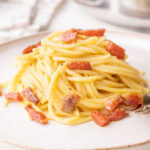Spaghetti Carbonara
Servings: 2 servings
Ingredients
- 1/2 pound (225g) dried spaghetti
- 4 ounces (115g) guanciale or pancetta/bacon
- 1 egg
- 2 egg yolks using just 1 egg yolk is also fine
- 1 ounce (30g) pecorino cheese
- 1 ounce (30g) parmesan*
- 1/4 teaspoon freshly ground black pepper or more, to taste
- 3-4 tablespoons pasta cooking water more if needed
- salt to taste
Instructions
- Cook the pasta: Bring well-salted water to a boil, add the pasta, and cook according to the package instructions until al dente. At the end of the cooking time, reserve about 1/2 cup of the pasta cooking water. Make sure not to overcook the pasta—it should still have a bite to it. The amount of water should be moderate, just enough for the pasta to freely swim in it. The less water you use, the more concentrated the starch in the water will be, which helps thicken your sauce.1/2 pound (225g) dried spaghetti
- Cook the guanciale: Cut the meat into small cubes or batons (thin strips about 1-inch (2cm) long). Add the guanciale to a cold frying pan and set it over medium heat. Cook for a few minutes until the fat renders (melts out of the meat), and the guanciale becomes browned and crispy. Transfer the guanciale to a plate, leaving the rendered fat in the pan. If your guanciale is very fatty, you can remove some of the excess fat, but be sure to leave enough to flavor the dish. Take the pan off the heat.4 ounces (115g) guanciale
- Make the pasta sauce: While the pasta and guanciale are cooking, prepare the sauce. Finely grate both types of cheese using the small holes of a grater or, preferably, a Microplane grater (very finely shredded cheese melts more easily). In a medium bowl, whisk together the egg and egg yolks until well combined. Add the grated cheese and freshly ground black pepper, and whisk again until the mixture is smooth and well combined.1 egg, 2 egg yolks, 1 ounce (30g) pecorino cheese, 1 ounce (30g) parmesan*, 1/4 teaspoon freshly ground black pepper
- Assemble: Drain the pasta and return it to the pan. Toss it with the reserved guanciale fat. If you’ve just finished cooking the guanciale, take the pan off the heat and let it cool for 1-2 minutes. The pasta and pan should no longer be sizzling, as excessive heat can cause the eggs in the sauce to scramble.
- Add the cheese-egg mixture and 3 tablespoons of the reserved pasta cooking water. Toss vigorously until the cheese melts and the mixture transforms into a creamy sauce. If the sauce is too thick, add more pasta cooking water, one tablespoon at a time, until the desired consistency is achieved. If the pasta is too cool and the sauce isn’t melting, you can return the pan to the heat on the lowest setting. Warm it very gently, stirring constantly, just until the sauce becomes creamy and smooth. Remove the pan from the heat immediately, as the sauce can scramble quickly if overheated, and this cannot be undone.3-4 tablespoons pasta cooking water
- Season the pasta with salt, if necessary (both types of cheese are already salty, so taste first), and generously sprinkle with lots of freshly ground black pepper. Top with the crispy guanciale and serve.
- Enjoy!
Notes
- You can use either just Parmesan cheese or just Pecorino cheese in this recipe. Traditionally, it’s made with just Pecorino cheese. I chose to use both because I prefer the milder, creamier flavor of Parmesan. While Parmesan and Pecorino are similar types of hard cheese, Parmesan is made from cow’s milk, while Pecorino is made from sheep’s milk, giving it a tangier and sharper flavor. Try both and decide which you like best!
- Don't use pre-shredded cheese, it will not melt as easily as freshly grated cheese!
- If using just 1 egg yolk, add just 1-2 tablespoons of water and then asses if you need more. The sauce will be thinner with less yolks.
- Calories = 1 serving (1/2 of the recipe). This is only an estimate!
Nutrition
Calories: 849kcal
